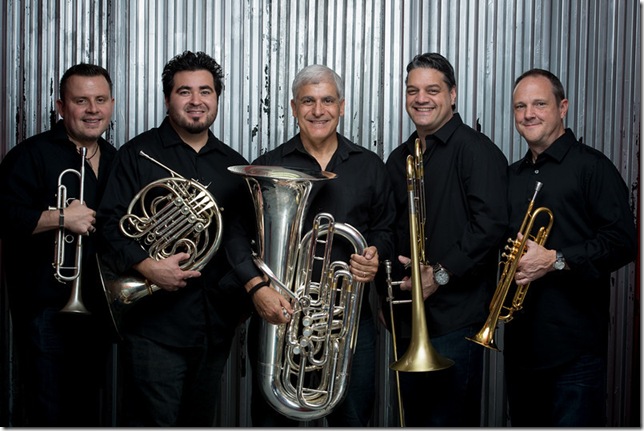The quintet known as Boston Brass — two trumpets, horn, trombone and tuba — joined the Palm Beach Symphony on Monday at the Flagler Museum for two memorable pieces dedicated to Shakespeare’s Romeo and Juliet: one by Prokoviev, the other by Bernstein.
Devoid of its own brass section of 12 players, Palm Beach Symphony fielded strings and percussion only. What an irony: In the past I have complained about the ripe acoustic of the hall housing the private rail car of the late Henry Flagler when the brass overwhelm the rest of the orchestra.
Not so this night. A near-perfect balance was achieved between Boston Brass and the strings. Conductor Ramón Tebar figured out the room’s reverberations could be overcome by placing his orchestra on a 6-inch-high wooden platform, set over the marble flooring, and cutting the brass in half.
Instead of opening with “Something’s Coming,” from West Side Story, as listed in the program, Boston Brass played Turina’s Danzas Fantásticas and two pieces by Johann Sebastian Bach, father to 20 children and some of the greatest Baroque music ever composed. The first Bach piece was an arrangement of “Sleepers Wake” (“Wachet Auf”) with the air played by a solo trumpet accompanied by the tuba. The second trumpet had some breath control problems toward the end of this piece.
Bach’s “Little Fugue” in G minor (BWV 578), a 68-bar wonder, closed the visitors’ opening solos. The first trumpet led off again followed by the second trumpet, and as in a sung round, each of the other three instruments joined in. Each player had the pleasure of showing off a little before ending on four distinct notes. Warm applause greeted them as they exited stage right.
Reappearing with Tebar in shirt-sleeves, they began the Prokoviev music arranged by J.D. Shaw, a former Boston Brass member. Prokoviev left Russia after the 1917 October Revolution but returned 20 years later after visits to America where his fellow Russian, Rachmaninov, held sway, and Europe, where he felt he couldn’t compete with Stravinsky, also a Russian emigré. Having written ballet music for Diaghilev in his twenties, he composed Romeo and Juliet dance music for the Kirov Ballet, which was then transferred to Moscow’s Bolshoi Ballet where it was aborted: Stalin’s cultural purges were underway.
From his first downbeat, Tebar got this newly mixed orchestral group moving in a romantic direction. Achieving a nice balance from the start, the piano added an extra fine dimension. Sweet strings playing harmoniously signified “The Maid Juliet.” Question and answer from strings to brass depict the immortal balcony scene, headed “Romeo and Juliet.” This dialogue is followed by racing music signifying Romeo must hurry away. Here the string playing was exquisite.
There was superb playing from Boston Brass during “Masks,” and Tebar showed himself in complete control as he led the lovely, engaging music of “Friar Laurence.” The strings sounded particularly lovely in “Montagues and Capulets,” with its famous to-and-fro tune representing the push and pull the young lovers get from their individual families. A lengthy silence after the piece remained unbroken. Enraptured by the music and the fine playing, the audience did not want to break the spell.
After intermission, Boston Brass played a rousing version of Bernstein’s “Something’s Coming,” very loudly, followed by Piazzolla’s “Milonga de Angel,” a lovely, short, delightful piece, quite captivating in its originality.
Leonard Bernstein’s Symphonic Dances from West Side Story ended the program. There is much exciting music in this piece, from the Cuban drums, xylophone and timpani that open the prologue to the “Mambo,” with the orchestra shouting the word two or three times and feet tapping, heads nodding in time all around me as the music was played.
There also was plenty of exciting playing in the “Cha-Cha,” “Meeting Scene,” and “Cool,” while in the Finale, the strings played with sweetness as the music of “Somewhere” took shape unobtrusively to end the suite.
